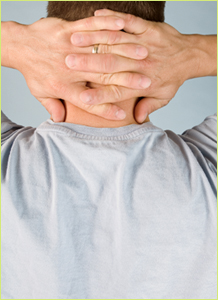Learn how to prevent back pain with these tips and exercises.
You've probably experienced back pain at some point in your life. But that doesn't mean you have to live with it. Learn about what causes this common problem, along with tips and exercises for preventing injuries and minimizing pain.
A pain in the back
Most back pain can be prevented by living a healthy lifestyle and avoiding activities that put added stress on the back. According to the U.S. Department of Health and Human Services, back pain can be caused by:
- Poor physical fitness
- Being overweight
- Your job, if your occupational demands require lifting, pushing, pulling, or twisting, or you work at a desk all day and don't have a proper ergonomic set-up
- Heredity, since some back pain can have a genetic component
- Other health conditions, including some types of arthritis, cancer, and infections
Getting older is also a prime factor, but that's not to say that younger people are immune from back pain. "I tend to see different problems at different ages across the lifespan," says David J. Pezzullo, Director of Physical Therapy for University Orthopedics, a practice serving the Rhode Island region. Pezzullo says stress fractures of the spine can occur in active teens; herniated discs often occur during midlife; and osteoarthritis of the spine, spinal stenosis (the narrowing of the space around the spinal cord and nerves), and other issues related to bone density and compression fractures occur in older adults, the result of a lifetime of normal wear and tear.
4 on the floor
The following four exercises from the U.S. Department of Labor, Occupational Safety & Health Administration are designed to strengthen your core—the muscles in your pelvis, lower back, hips, and abdomen—and help you avoid back injury. They can be done every day in the order listed below. Before you start, keep in mind that every body is different. "Exercises that might be helpful for one back problem might be harmful to another," Pezzullo points out. So consult with your healthcare provider before you try these exercises, and don't do those that cause pain or get more difficult to do over time.
The pelvic tilt
Helps strengthen your stomach, buttocks, and thigh muscles, as well as stretch your lower back muscles. This exercise flattens the back, then lets the back return to its natural curve.
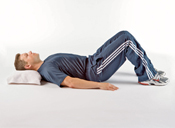 1. Lie flat on your back on the floor with head resting on a small pillow. Bend knees and hips so both feet are flat on the floor. Push lower back flat to the floor. Make sure your back is flat by trying to place your hand between your back and the floor. (When done correctly, your hand shouldn't fit.) Now tighten your stomach and buttock muscles.
1. Lie flat on your back on the floor with head resting on a small pillow. Bend knees and hips so both feet are flat on the floor. Push lower back flat to the floor. Make sure your back is flat by trying to place your hand between your back and the floor. (When done correctly, your hand shouldn't fit.) Now tighten your stomach and buttock muscles.
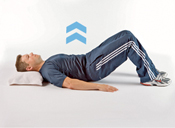 2. Lift your hips from the floor and tilt your whole pelvis forward while keeping your back flat against the floor. Hold for a count of 10.
2. Lift your hips from the floor and tilt your whole pelvis forward while keeping your back flat against the floor. Hold for a count of 10.
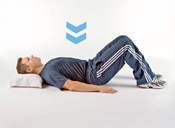 3. Slowly relax.
3. Slowly relax.
Repeat exercise 10 times.
Reverse sit-ups
Many people have weak abdominal ("stomach") muscles and tend to arch their backs while doing sit-ups. "Reverse" sit-ups strengthen the three groups of muscles that make the abdomen strong.
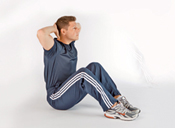 1. Sit on the floor in an upright position with knees bent. Lock hands together behind your head and hold your elbows out.
1. Sit on the floor in an upright position with knees bent. Lock hands together behind your head and hold your elbows out.
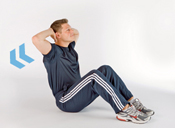 2. Tighten your stomach muscles and slowly lean back about 15 degrees, which is like going from 12 noon to 11 o'clock on a timepiece. Hold this position for a count of five (10 if you can).
2. Tighten your stomach muscles and slowly lean back about 15 degrees, which is like going from 12 noon to 11 o'clock on a timepiece. Hold this position for a count of five (10 if you can).
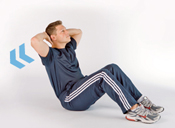 3. Slowly lean back to the 10 o'clock position. Hold and count again.
3. Slowly lean back to the 10 o'clock position. Hold and count again.
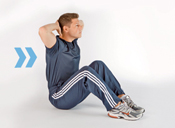 4. Return slowly to an upright position.
4. Return slowly to an upright position.
Repeat exercise 10 times.
Tip: Start by only going back to the 11:00 position and work up to going back to the 10:00 position.
Hamstring stretches
When hamstring muscles are shortened or tight, they interfere with bending. You can stretch them by doing the following exercise.
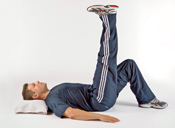 1. Lie on back with knees bent and feet flat. Extend right leg straight up, keep left knee bent.
1. Lie on back with knees bent and feet flat. Extend right leg straight up, keep left knee bent.
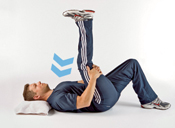 2. Wrap hands or towel around right thigh. As you exhale, bring right leg closer to your chest.
2. Wrap hands or towel around right thigh. As you exhale, bring right leg closer to your chest.
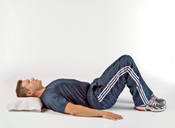 3. Release and place both feet on the floor.
3. Release and place both feet on the floor.
Repeat, extending left leg.
Repeat exercise 5 times, one leg at a time.
Lumbar stretches
When lumbar muscles are tight, they become shortened and interfere with bending, twisting, and pelvic rotating. Keeping these muscles stretched also helps keep the natural curves of the spine in shape.
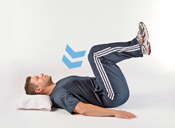 1. Lie flat on your back on the floor with your head on a small pillow. Bend your knees and slowly bring them toward your chest.
1. Lie flat on your back on the floor with your head on a small pillow. Bend your knees and slowly bring them toward your chest.
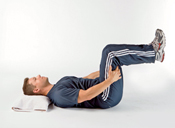 2. Reach your hands behind your thighs to help bend the knees. (Note: Pulling from the top of the knee isn't good for the knees.) Don't bounce.
2. Reach your hands behind your thighs to help bend the knees. (Note: Pulling from the top of the knee isn't good for the knees.) Don't bounce.
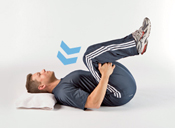 3. Keep your head on the pillow and elevate your buttocks as high as possible off the floor. Your knees should be as close as possible to your chest. Hold this position for a count of 10. Then relax, but continue to hold onto your thighs.
3. Keep your head on the pillow and elevate your buttocks as high as possible off the floor. Your knees should be as close as possible to your chest. Hold this position for a count of 10. Then relax, but continue to hold onto your thighs.
Repeat exercise 10 times.



